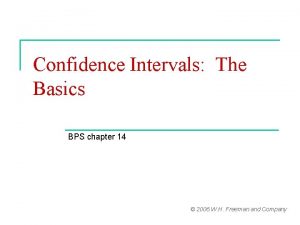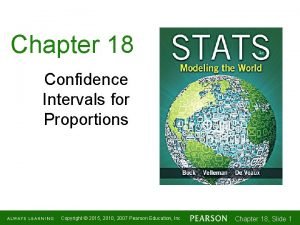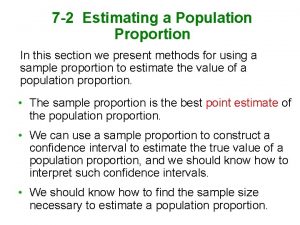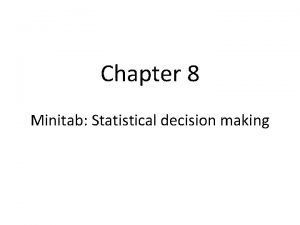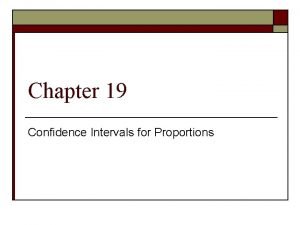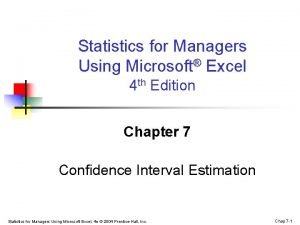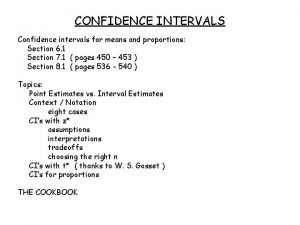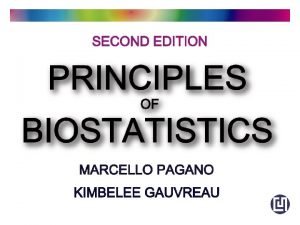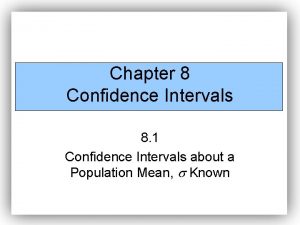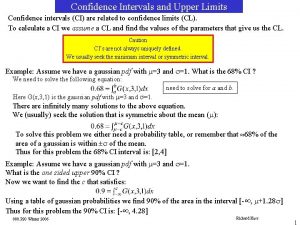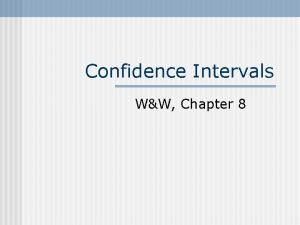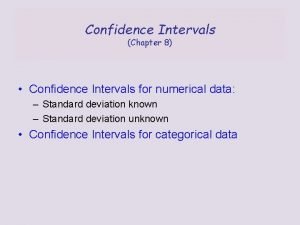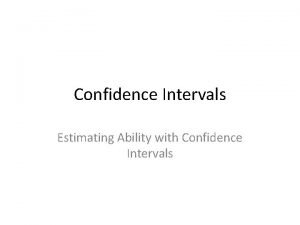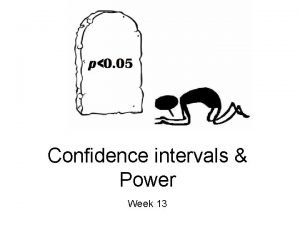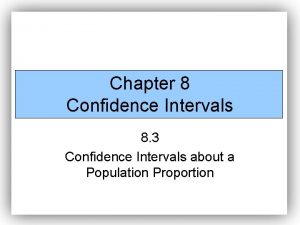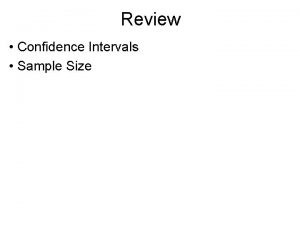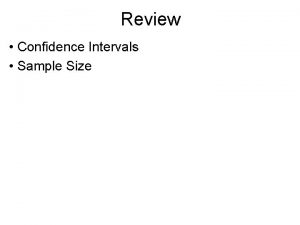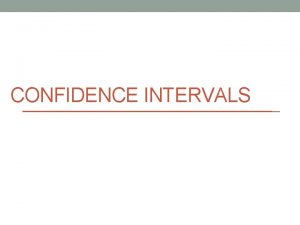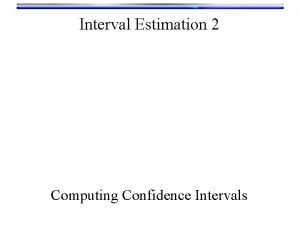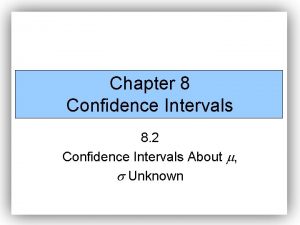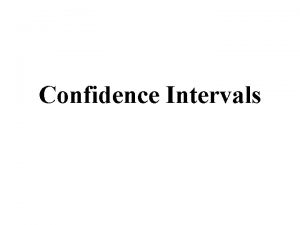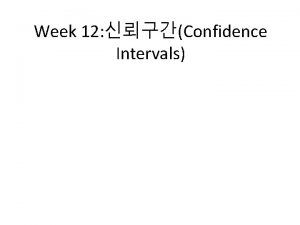Confidence Intervals Rate your confidence 0 100 Name
























- Slides: 24

Confidence Intervals

Rate your confidence 0 - 100 • Name my age within 10 years? • within 5 years? • within 1 year? • Shooting a basketball at a wading pool, will make basket? • Shooting the ball at a large trash can, will make basket? • Shooting the ball at a carnival, will make basket?

What happens to your confidence as the interval gets smaller? The larger your confidence, the wider the interval.

Point Estimate • Use a single statistic based on sample data to estimate a population parameter • Simplest approach • But not always very precise due to variation in the sampling distribution

Confidence intervals • Are used to estimate the unknown population mean • Formula: estimate + margin of error

Margin of error • Shows how accurate we believe our estimate is • The smaller the margin of error, the more precise our estimate of the true parameter • Formula:

Confidence level • Is the success rate of the method used to construct the interval • Using this method, ____% of the time the intervals constructed will contain the true population parameter

What does it mean to be 95% confident? • 95% chance that m is contained in the confidence interval • The probability that the interval contains m is 95% • The method used to construct the interval will produce intervals that contain m 95% of the time.

Critical value (z*) • Found from the confidence level • The upper z-score with probability p lying to its right under the standard normal curve Confidence level 90% 95% 99% z*=1. 645 tail area z*=1. 96 z*=2. 576 z*. 05. 025. 005 1. 645. 025 1. 96. 005 2. 576

Confidence interval for a population mean: Standard Critical value deviation of the statistic estimate Margin of error

Steps for doing a confidence interval: 1) Assumptions – • • SRS from population Sampling distribution is normal (or approximately normal) • • Given (normal) Large sample size (approximately normal) Graph data (approximately normal) s is known 2) Calculate the interval 3) Write a statement about the interval in the context of the problem.

Statement: (memorize!!) We are ____% confident that the true mean context lies within the interval ______ and ______.

A test for the level of potassium in the blood is not perfectly precise. Suppose that repeated measurements for the same person on different days vary normally with s = 0. 2. A random sample of three has a mean of 3. 2. What is a 90% confidence interval for the mean potassium level? Assumptions: Have an SRS of blood measurements Potassium level is normally distributed (given) s known We are 90% confident that the true mean potassium level is between 3. 01 and 3. 39.

95% confidence interval? Assumptions: Have an SRS of blood measurements Potassium level is normally distributed (given) s known We are 95% confident that the true mean potassium level is between 2. 97 and 3. 43.

99% confidence interval? Assumptions: Have an SRS of blood measurements Potassium level is normally distributed (given) s known We are 99% confident that the true mean potassium level is between 2. 90 and 3. 50.

What happens to the interval as the confidence level increases? the interval gets wider as the confidence level increases

How can you make the margin of error smaller? • z* smaller (lower confidence level) • s smaller (less variation in the population) • n larger Really cannot (to cut the margin of error in half, n must change! be 4 times as big)

A random sample of 50 SWH students was taken and their mean SAT score was 1250. (Assume s = 105) What is a 95% confidence interval for the mean SAT scores of SWH students? We are 95% confident that the true mean SAT score for SWH students is between 1220. 9 and 1279. 1

Suppose that we have this random sample of SAT scores: 950 1130 1260 1090 1310 1420 1190 What is a 95% confidence interval for the true mean SAT score? (Assume s = 105) We are 95% confident that the true mean SAT score for SWH students is between 1115. 1 and 1270. 6.

Find a sample size: • If a certain margin of error is wanted, then to find the sample size necessary for that margin of error use: Always round up to the nearest person!

The heights of SWH male students is normally distributed with s = 2. 5 inches. How large a sample is necessary to be accurate within +. 75 inches with a 95% confidence interval? n = 43

In a randomized comparative experiment on the effects of calcium on blood pressure, researchers divided 54 healthy, white males at random into two groups, takes calcium or placebo. The paper reports a mean seated systolic blood pressure of 114. 9 with standard deviation of 9. 3 for the placebo group. Assume systolic blood pressure is normally distributed. Can you find a z-interval for this problem? Why or why not?

Some Cautions: • The data MUST be a SRS from the population • The formula is not correct for more complex sampling designs, i. e. , stratified, etc. • No way to correct for bias in data

Cautions continued: • Outliers can have a large effect on confidence interval • Must know s to do a z-interval – which is unrealistic in practice
 100 100 100 100 100
100 100 100 100 100 Deveiation
Deveiation Confidence interval vs confidence level
Confidence interval vs confidence level Reporting confidence intervals
Reporting confidence intervals T score for 95 confidence interval
T score for 95 confidence interval Chapter 19 confidence intervals for proportions
Chapter 19 confidence intervals for proportions 90 confidence interval excel
90 confidence interval excel Chapter 18 confidence intervals for proportions
Chapter 18 confidence intervals for proportions Common critical values
Common critical values Calculate confidence interval ti 84
Calculate confidence interval ti 84 Confidence intervals minitab
Confidence intervals minitab Chapter 19: confidence intervals for proportions
Chapter 19: confidence intervals for proportions How to add 95 confidence intervals in excel
How to add 95 confidence intervals in excel Confidence interval variance formula
Confidence interval variance formula What is your name and how old are you?
What is your name and how old are you? Rate your confidence level
Rate your confidence level Confidence interval vs confidence level
Confidence interval vs confidence level Name all rays
Name all rays Name
Name Global user
Global user Your conscious awareness of your own name
Your conscious awareness of your own name 400 un yuzde 20'si
400 un yuzde 20'si 200+200+100+100
200+200+100+100 Box plot gcse
Box plot gcse Malloc lab 100/100
Malloc lab 100/100



